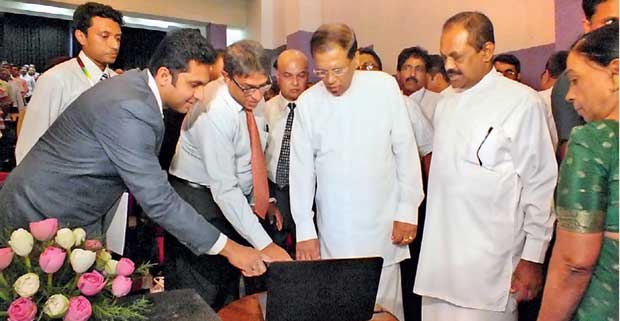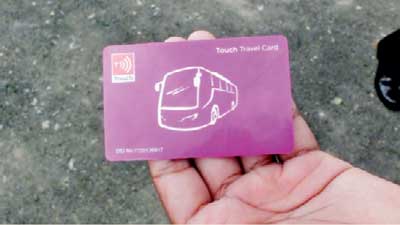Reply To:
Name - Reply Comment
Last Updated : 2024-04-24 09:30:00


The transport problem has become a burning issue for the people of the country and a substantial percentage of the productive time of the workforce has been lost on choked streets as a result of chronic vehicular congestion. The situation is further exacerbated by workers arriving at their work places already tired out, preventing them from being able to execute their tasks efficiently. Overall, the situation is a terminal blow to the economy of the country.
Vehicular congestion on the roads of Sri Lanka is due to near-complete breakdown of the public transport system and killer competition between bus operators. Commuters can never predict when they will reach their destination since the buses are either racing each other during peak hours or crawling along at snail’s pace at other times.
Accidents have spiked significantly over the last decade and errant bus drivers have been a significant cause of it and commuters have deserted public transport systems en masse. The 65% of the public who used public transport in 2008 has dropped to 40% today.

Desperate commuters had to look for alternative transport, spiking the number of 2, 3 and small 4-wheel vehicles. At present 100,000 cars, 130,000 three-wheelers, 40,000 vans and 370,000 motor vehicles are put on the roads each year, increasing the severity and frequency of traffic snarls.
Massively-funded roadwork has failed to resolve the problem due to this uncontrolled entry of vehicles. Road accidents and human casualties have spiked and the enforced investment on the part of the general public for private transportation has resulted in untenable monthly financial burdens to maintain their vehicles. In short, transport has ceased to be a right enjoyed by Sri Lankans.
After the introduction of private buses to the country in 1978, successive governments are to be blamed for continuing to add more and more needless employees to the SLTB purely to further political ends, and the SLTB now has 38,000 employees and just 5,500 buses increasing its financial burden.
The revenue model introduced along with private buses where each bus was responsible for its own income was erroneous and prevented cohesion and understanding among the operators of buses on any given route. Despite the fact that commuter traffic varies with time, the income method made it impossible for a common mechanism and the sharing of profits fairly. This is a ludicrous system not seen anywhere else in the world and prevented eradication of inter-operator competition and reduced the private bus transport system in Sri Lanka to a self-employment mechanism with a large number of uncoordinated, individual, small entrepreneurs, rendering the entire system dysfunctional.
The approximately 22,000 private buses in Sri Lanka and the 5,500 operated by the SLTB are sufficient to provide Sri Lanka with an excellent public transport service. Studies have affirmed that lack of buses never caused the breakdown of public transport.
The only solution recommended by the State was to consolidate a common timetable but this is similar to an attempt to treat a wound in the leg with a pedicure. As long as there is inter-operator competition it is impossible to have them adhere to a common timetable. All that happens is that the fight changes to obtaining choice slots within the timetable. Therefore the SLTB trade unions were opposed to such a course of action and the recommendation was binned.
The solution is actually very simple. The basis for it is that the total daily take of a bus operator should not depend on the number of commuters who board that particular bus. Rather, it should be determined by the total take of all buses plying a route on a given day which should then be fairly distributed among all operators based on the total number of turns each bus plied its route. The SAHASARA programme is the method through which the government will ensure that this goal is met.
Through this programme, the commuter is ensured of a good quality service and the entrepreneurial mindset of the bus owner and bus employee are changed. Collaterally, bus drivers and conductors become more disciplined and have no reason to resort to risky or dangerous driving. The responsibility of the bus employees is to ensure that their buses run on time, that they take in only the number of commuters that can be comfortably seated in buses and be concerned for their comfort. Such assurance of service quality ensures that those using private vehicles return to public transport for their daily commutes increasing the revenue of public bus services. In a nutshell, the SAHASARA programme is a massive revolution in public transport.
The question then is how a passenger will pay for the commute. In the previous system, the fare that a commuter pays the conductor goes toward the take of that specific bus only. However, the SAHASARA programme,uses modern technology to engineer a total-take based system with every bus provided with an electronic card reading ticket machine, a GPS and a CCTV camera.
The commuter simply purchases a prepaid SAHASARA card in much the same way a prepaid mobile phone card is purchased. Once the commuter boards the bus a ticket can be purchased using this card and the card is debited the amount of the fare. Not only is this a clean and efficient system it will completely eliminate the problems commuters face with trying to obtain their balance from conductors in the old system. Later, a commuter is free to top-up (reload) the card to any amount.
Purchasing and reloading their cards can be done at the same outlets that supply services for their mobile phones or a bus conductor or the bus stand.
Since the public is quite conversant with prepaid card systems, the SAHASARA card will become second nature very quickly. However, even if a commuter doesn’t have such a card, cash can be paid to the conductor at the time of boarding and the conductor swipes his own SAHASARA card to issue a ticket.
At the end of the day, the conductor simply reloads his own card with cash obtained from passengers, who didn’t have one. This essentially means that the passenger pays for his travel not at the time of boarding a bus but rather, at the time of purchase of the SAHASARA card. All those funds are credited to a common fund of the route’s bus operators. Each passenger’s commute is automatically registered through communications technology at the control centre for each transport zone where there is an operations room dedicated to its oversight. Each has a control committee and an auditor who checks operations on a weekly basis and these reports will be available to the public.
Additionally, an advisory board comprising of bus owners, SLTB officials, support service representatives and sector experts will provide oversight, monitoring and guidance to each zonal system.
The beauty of the system is that neither the bus owners nor the general public need incur additional costs because the cost of the technology and the administrative costs of the control centres will amount to less than 3% of the total take from commuters.
Furthermore, the number of commuters resorting to public transport is anticipated to rise very steeply increasing the total revenue of the transport system enabling bus owners to quickly pay back the capital costs of their buses. Therefore, if there are no additional costs incurred by bus owners, the SAHASARA programme might even create the conditions where fares might in fact be reduced in the future.
The present system of season tickets and concessionary passes will continue as usual with the SAHASARA programme. Those who enjoy such concessions from the government will now have the additional advantage of not having to wait for a SLTB bus to get to their destinations since the same concessions will be available to them through SAHASARA buses.
Bus employees also stand to benefit from the programme since their job security increases and they get access to welfare funds and reduced contention with commuters since they will be providing high quality services to the public. Moreover, the jobs of these workers will reach a much higher level of dignity.
The pilot of the SAHASARA programme was launched a few days ago by His Excellency the President Maithripala Sirisena. This will be implemented on the Kandy-Kadugannawa and Kandy-Digana routes as well as their feeder routes. The Kandy-Pilimatalawa-Kadugannawa route will be known as the Denuwara zone and the Kandy-Kundasale-Digana route will be known as the Dumbara zone and will encompass a total of 300 buses. Additionally, buses from four SLTB depots also ply these routes. All of these buses are slated to be connected through a two-stage strategy. The pilot will terminate in three months and checks and balances implemented based on the practical outcomes of the system. Subsequently, the government plans to implement the system across the country within the course of this year.

Add comment
Comments will be edited (grammar, spelling and slang) and authorized at the discretion of Daily Mirror online. The website also has the right not to publish selected comments.
Reply To:
Name - Reply Comment
US authorities are currently reviewing the manifest of every cargo aboard MV
On March 26, a couple arriving from Thailand was arrested with 88 live animal
According to villagers from Naula-Moragolla out of 105 families 80 can afford
Is the situation in Sri Lanka so grim that locals harbour hope that they coul